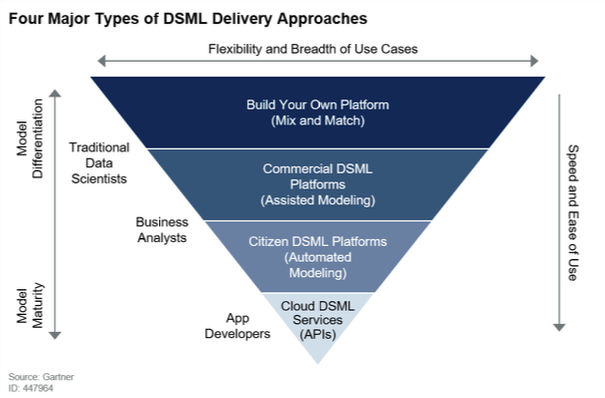DataRobot was founded in 2012 with the vision that enterprise AI has the potential to deliver transformational power to organizations around the world. Today, we’re seeing that vision play out as AI has become a business imperative, helping to turn data into real business impact. There isn’t a day that goes by without a story in mainstream publications, like The Wall Street Journal or The New York Times, talking about how AI is transforming lives or helping companies reinvent themselves.
According to a recent McKinsey report, fast adopters of AI who proactively absorb it into the fabric of their business are going to see exponential gains in their cash flow. What’s more, the operational and financial efficiencies that fast AI adopters will gain over their competitors have a compounding effect, meaning that the AI gap will widen to a point that laggards may never catch up and will face an existential threat.
The time to act is now, and companies have a few options to consider:
- Aggressively hire large teams of expert data scientists. This is the route that companies such as Apple, Google, Facebook, Uber, and others have taken, and few can argue with their success. But that success doesn’t come cheap as hiring and retaining a small army of data scientists is a very expensive option. And, unless the company is located in an area where deep pools of data science talent exist, this really isn’t a practical option even if they have deep pockets.
- Supplement the existing expert data science talent they have by empowering citizen data scientists. This is the strategy that we’re seeing from most of the companies that are serious about making AI part of their DNA. They hire a few data scientists to build a basic competency for AI but look for platforms that can democratize AI and machine learning. This tactic helps them overcome the data science talent shortage by empowering capable and motivated data analysts, data engineers, software developers, and others on their way to building and deploying AI and machine learning at scale.
- Ignore the potential of AI. History is filled with examples of companies that trusted in previous competitive advantages and failed to recognize key technologies that would forever change their industry. Kodak invented the first digital camera in 1975, yet they were convinced that no one would ever want to look at their pictures on a television set. Blockbuster dismissed the threat from online upstart Netflix. And Xerox invented the graphical user interface, yet naively showed the concept to Apple who quickly incorporated it into their operating system. AI is different in that it has the potential to disrupt ALL industries.
Automated Machine Learning, or Augmented Data Science and Machine Learning (DSML) according to Gartner, is arguably the most powerful enabling technology under the AI umbrella. Automated Machine Learning helps the expert data scientists deployed under the first two strategies complete more projects because it automates the time-consuming and tedious aspects of data science. Automation allows them to focus their attention on the human aspects of AI, while also giving them exposure to new types of algorithms that they normally might not have time to learn given their existing workload. Empowered and enabled citizen data scientists in the second strategy can use automated machine learning along with their unique domain knowledge to build machine learning models and increase their company’s overall capacity for AI. Guardrails built into platforms such as DataRobot ensure that data science best practices are consistently followed, even by people who don’t have extensive data science training and experience.
In their recent report, “How Augmented Machine Learning Is Democratizing Data Science”, Gartner analysts acknowledge the profound impact that augmented machine learning will have on organizations:
“When successful, augmented DSML simultaneously improves the ROI of data science investments, reduces time to value and expands the footprint of ML. Experts become more efficient and productive, and a wider population of quantitative professionals becomes capable of contributing to data science success.”
Each section of the report describes how augmentation impacts each element of the traditional, end-to-end DSML workflow:
- Data Management (data acquisition, data exploration, and data preparation)
- Model Selection (feature engineering and model selection)
- Model Training and Hyperparameter Tuning
- Model Deployment and Operationalization (deploy/manage and infer)
Then, the report discusses the four major types of DSML delivery approaches that are available today and provides examples of vendors who are delivering solutions using that approach. We’re pleased that Gartner has recognized DataRobot for our contributions in the “Build Your Own Platform” delivery approach with our MLOps product, and for what we believe is our leadership and pioneering efforts in automated machine learning as part of the “Citizen DSML Platforms” delivery approach.

We want you to be one of the fast adopters of AI, and realize the first-mover advantages described by McKinsey. That’s why we’re offering a complimentary copy of this valuable Gartner research report (as well as Gartner’s 2019 Magic Quadrant for Data Science and Machine Learning Platforms) to help you learn more about the power of automation throughout the DSML workflow, and select a DSML delivery approach that’s right for you.
About the author
Bob Laurent
Sr. Director of Product Marketing at DataRobot
Prior to DataRobot, he ran product marketing at Alteryx, where he was responsible for driving awareness and growing a loyal customer base of empowered data analysts. He has more than 20 years of marketing, media relations, and telecom network engineering experience with Fujitsu and NYNEX (now Verizon). Bob resides in Dallas with his wife and two boys, and holds a Bachelor of Science degree from Clarkson University, plus an MBA from New York University’s Stern School of Business.








